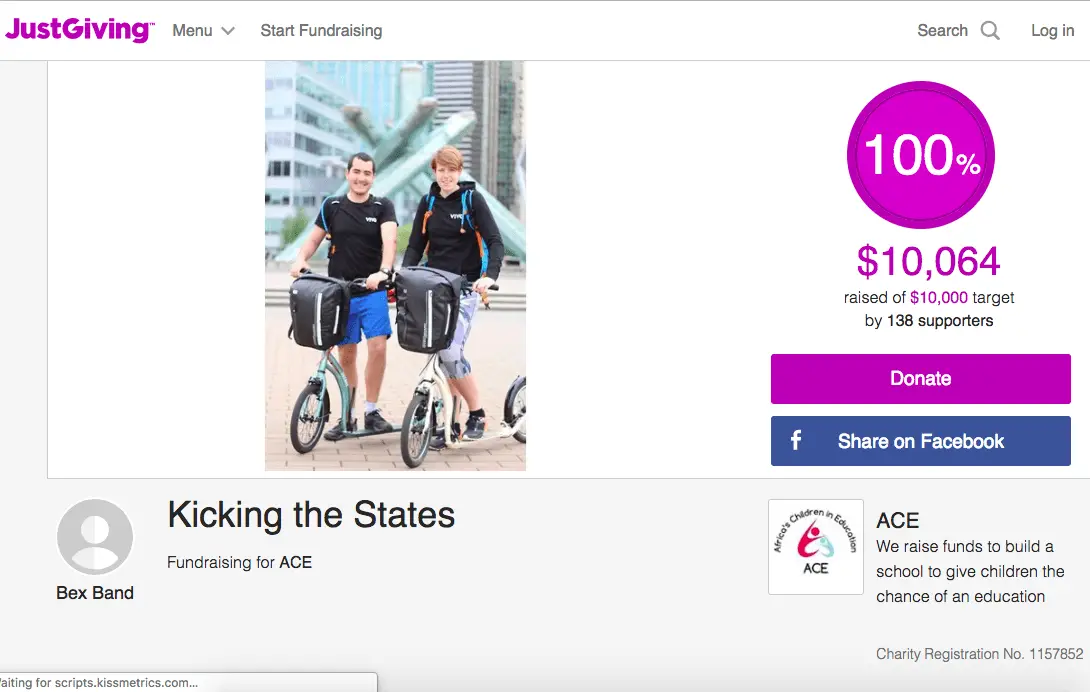Arguably, sponsorship collections are one of the easiest (and also risk-free) ways to raise money for charity. In most cases, this involves someone taking on a challenge – such as a sky dive or run – and in return asking their friends and family to donate money for a chosen charity. But how do you actually go about getting people to sponsor you and donate money?
I’ve asked for sponsorship and donations many times before. Like when I did my Kicking the States adventure – kick-scooting the length of the USA to raise money for a school in Tanzania. Without donations coming in from family, friends and kind strangers, we never would have reached our $10,000 fundraising target. You can read more about my other mad charity adventures here!
Getting people to sponsor you isn’t always easy, and it can feel horrible when the donations start to dry up. But following these 15 top tips will help you reach your target……
You might also want to check out:
- 8 charity fundraising ideas
- Top tips for organsing a fundraising event
- Raffle prize ideas & how to get companies to donate them
- How to do a press release
1. Is it a big enough challenge?
The bigger the challenge you set, the more likely you are to get donations.
People want to see you suffer!
Creativity is also your best friend when it comes to fundraising. Think about how many times your contacts been shown sponsorship forms for marathon races. Dozens of times! But how often have they been sent a sponsorship form for someone trying to pogo stick the length of the UK?
Try and make your challenge or adventure a little different to attract attention. If that’s not possible ask what you can do to make yourself stand out. It could be something as similar as wearing a particular costume or carrying a flag.
2. Tell a story
The most successful fundraisers are usually people who have a story or reason for fundraising for a charity. Think about your motives and how you might make your fundraising journey more personal.
The more personal you make your fundraising jounrey and the more honest you can be about this, the more engaged peeople will be with what you are doing.
What makes you want to donate more:
- A lady running a race for a heart charity
- A lady running a race for a heart charity in aid of her brother who she sadly lost when she was younger due to an undiagnosed heart condition
3. Online is best
Most charities will already have an online platform that they are signed up to for fundraisings like Mydonate or Just GIving.
Having an online sponsorship page makes donating easy for your supporters and also eliminates any worry about the money going directly to the charity. People know they can trust it.
Get your page looking good from the start. Add photos and a description. Or even better, a video (remeber about keeping it personal!). Use all the features the fundraising page might have like adding updates or thanking donors after they’ve given.
4. Set up a text option
A lot of platforms now also offer a texting service. Someone can simply text a donation amount to a set number and the donation will be taken off their phone bill.
Use this option if it is there. It’s so quick and easy for people to donate this way. You can also easily print this onto a Tshirt or onto slips of paper to handout: ‘Text GIVETODAVE to give £5 to Christian Aid’.
5. Encourage Gift Aid
If you are a UK taxpayer you can easily increase any donation by 25% by claiming gift aid. You don’t pay for this 25%, the government does. And all you need to do is tick the gift aid box when you donate online!
If someone has said they will donate remind them to gift aid it.
This is our fundraising page from Kicking the States. Although we raised $10,000, the charity actually got a lot more than this because all our UK givers added Gift Aid.

6. Be specific with where the donations are going
It’s become common for people to use sponsorship money as a way to fund a challenge or adventure. Although some of the money goes to charity, people generally are not keen on supporting this kind of fundraising. You can probably understand why!
Be really clear on your sponsorship form and when asking for donations where the money is going.
If all of it is for the charity then great….put that 100% of donations go to the charity. Make it clear that you are paying for the challenge yourself as this will be a big selling point to a lot of people.
7. Never advertise an empty sponsorship page
If you are setting up a fundraising page, get your nearest and dearest to give donations before advertising it to a wider audience. Or you can even contribute yourself and set up a few fake donations.
People support things that are successful. An empty fundraising page is a huge deterrent. It’s a strange psychology but it’s the reason why viral donations and gofundme pages do so well.
8. Ask, ask and ask again
Most people need to see an ask or request 3-5 times before they act on it. It’s important to remember this when asking for sponsorship.
You might feel like you are being too pushy or repetitive but it’s human nature to need to be reminded multiple times before responding.
It’s also worth noting that with social media, each time you post only a small percentage of your followers will see it. So even if you post 10 times, the chances of one of your followers seeing even half of those posts are slim.
9. Send a direct email out
As soon as you have committed to a charity challenge, send an email out to all your contacts asking them directly to support you and to follow your journey on social media. Send another email out a week or so before the event. And then a final one once you’ve completed it.
You can also ask if they would be willing to share your fundraising page on their social media platforms.
10. Make a video
Videos are the most engaging way to capture peoples attention. Make sure you keep it really short….or even better….get your kid to do it!
I think video is a really powerful tool. I’d recomend using videos to update people and to keep them engaged with your training, preperation and charity challenge.
Getting creative with your films as well – making them funny – will mean people are more likely to share it.
11. Tap into your socials
Keep adding updates and finding new content that you can share online. Do this on all the social meida platforms you use.
Use your training and preparation as a way to get people engaged in your adventure. Share photos and stories of the good times and bad times and always add a link with your sponsorship form.
12. Going beyond your network
Getting your friends, family and colleagues to donate should be the easier part of fundraising. It becomes trickier with people you don’t know.
I like to print out a small card with the challenge I am doing and for which charity along with details of how people can follow and donate. Try and leave this with any new people you meet during your fundraising journey.
If you are doing a challenge where you will pass people you can also carry a collection bucket. Although most will only throw in coins, this can soon start to add up.
I would also ask the charity you are supporting if they would include your challenge efforts in their newsletter. You can also do this for any other network you might be connected to – parents groups, book clubs, WI, sports club etc.
13. Tap into your local press
Try and get yourself in the local press, radio and news….or even national if you are doing a really big or unusual challenge. This is a great way to spread the word.
Even if I don’t get many donations directly, I found that sharing an article on my fundraising website or social media gives the challenge more weighting which will encourage donations from people who are checking your credibility online.
Check out: How to do a press release

14. Keep plugging post-challenge
Once you’ve completed the challenge your job is not complete. A huge chunk of donations come after an event….I guess people want to see you will actually do it first! You might also get some early supporters donating for a second time. So be really active with asking for sponsorship the week after your event.
15. Remember those thank you’s
It’s nice to send a personal message to everyone who donate.
I would also encourage you to post ‘thank you’s’ on your social media pages as it’s a great way to encourage people to get involved and get their slice of gratitude too!
Resources: how to get people to sponsor you
Regardless of how your sponsorship efforts go, you should feel proud. A lot of charities rely heavily on income of this kind and even the small donations can really add up.
For inspiration from others who have raised a significant amount through sponsorship check out these websites to see how they’ve made their charity challenges engaging:
As a big challenge with sponsorship is getting over the awkwardness/fear of asking….I’d seriously recommend getting your hands on a copy of The Art of Asking by Amanda Palmer.
It will help you get over your nerves about asking for money and will teach you confidence techniques to make you a more effective fundraiser.
And if you’ve got any advice that I’ve missed out, please share using the comments box below. You may help inspire others!
If you found this blog helpful, follow my blog and adventures on Facebook, Twitter and Instagram. Or you can subscribe to my YouTube channel. I give all my advice out for free on my website. If you want to say thanks, you can buy me a coffee!







You’re doing well people. Am in medical school pursuing diploma in clinical medicine and surgery. Kindly support in raising school fees
Thank you for reminding me that while it is easy to ask my family members and friends to donate, it gets harder the more I reach to other people that I don’t personally know. Still, I want to pursue my goal no matter how hard it is. After volunteering for an orphanage, my experience made me realize how child abandonment is really an issue these days that people should be aware of. Although I can’t blame parents who aren’t ready at all, I still think that this charity should get more attention and funds since the children’s future lives are at stake here.
How can I get a sponsor to complete my university degree